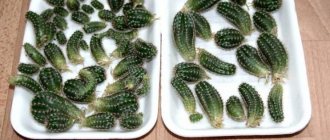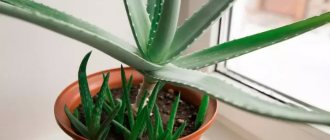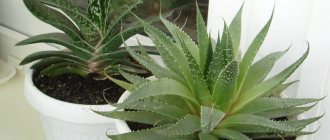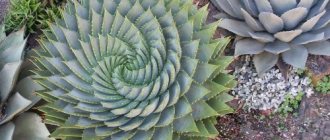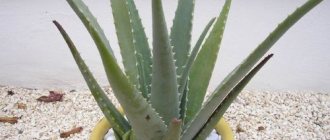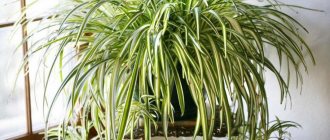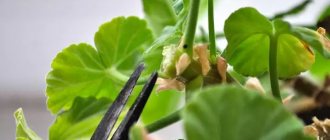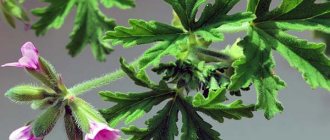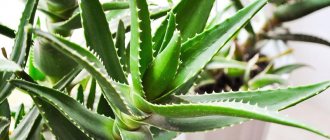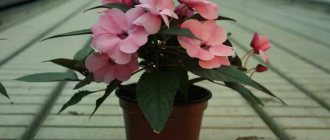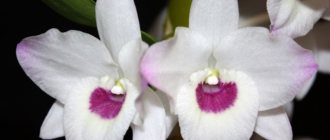- July 23, 2019
- Houseplants
- Ksenia Stepanishcheva
Many indoor flower lovers plant aloe at home. This plant is known for its medicinal properties, so it is often used in folk medicine. However, not everyone knows the intricacies of cultivation. How to plant aloe is described in the article.
The plant is also called agave. It is part of the succulent family. There are over 500 species of aloe. Some of them are grown at home. Aloe vera is often grown on windowsills. Planting is carried out according to certain rules, subject to which the color will be healthy and beautiful.
What kind of land is required?
Under natural conditions, aloe grows in poor sandy desert soils. Succulents are also found on rocky soils at low plateau heights. How to grow aloe at home? A special substrate is required, including:
- humus soil - 1 part;
- coarse and fine river sand - 2 parts each;
- perlite – 1 part;
- vermiculite – 1 part.
The plant feels comfortable in this soil mixture and develops normally. But for adapted plants, a gentle and fertile composition can be used, including:
- turf soil - 6 parts;
- greenhouse soil – 1;
- leaf humus – 2;
- peat – 2;
- sand – 2.
You can choose a store-bought mixture “For succulents and cacti.” A 2-3 cm layer of drainage should be placed in the container. Plants are replanted every year. It is advisable to do this in the spring at the beginning of the growing season, although aloe normally tolerates transplantation at any time, with the exception of the rest period.
How to plant aloe correctly at home
This plant belongs to the category of succulents. Therefore, aloe prefers well-lit window sills and easily tolerates a lack of moisture, as it accumulates it in its leaves with rare watering. If the basic requirements of the culture are met, this plant will not cause any trouble.
Aloe is rightfully considered a home healer.
Note! For its full development, it is important to plant correctly. This procedure includes several main steps. Therefore, it is worth familiarizing yourself with them in advance.
What time of year is it better to plant and is it possible in winter?
It is best to plant aloe, like other indoor plants, in late February - early March. It is during this period that the plant emerges from the state of winter dormancy and biological processes intensify.
If it was not possible to plant during this period, then you can postpone the procedure until the end of summer, namely until July-August. At this time, sap flow in the tissues of the plant increases, so it easily tolerates planting and quickly recovers
Important! Planting aloe in late autumn, as well as at the beginning and middle of winter, is not recommended, since at this time the plant is in the dormant stage and will not be able to fully take root, which means it will die.
What kind of soil is needed for aloe
In nature, this plant can be found in countries with arid climates and soil poor in nutrients. At the same time, aloe feels great in such conditions and grows well. Therefore, it is necessary to prepare soil for it, the composition of which will be as close as possible to its natural habitat.
You can purchase a ready-made substrate at a flower shop, choosing a soil mixture for cacti and succulents. But you can also prepare suitable soil for aloe yourself. The main thing is that the substrate is loose, light and well-drained.
To plant aloe you will need to mix the following components:
- turf - 40%;
- leaf soil - 20%;
- coarse sand – 20%;
- small pebbles - 10%;
- charcoal - 10%.
Important! Peat should not be added to the soil, as it increases acidity, and this has a depressing effect on the roots of the plant.
The soil for aloe should not be nutritious, the main thing is that moisture does not stagnate in it.
In what container is aloe grown: pot sizes
The root system of aloe, like all succulents, is small, but the leaves are fleshy and large, since they contain a supply of moisture and nutrients. Therefore, it is necessary to select not too deep, but wide pots for the plant. When planted in high containers, the plant will constantly turn over.
The diameter of the pot should be selected depending on the age of the seedling
At the initial stage of growth, the width of the planting container should be within 8-9 cm. With subsequent transplants, it can be increased by 2-3 cm.
For your information! You cannot immediately plant aloe in a container that is too large, as the excess soil in the pot will begin to turn sour and cause root rot.
Capacity
When considering how to grow aloe, you should delve into the issue of choosing a pot. The plant has a small root system and heavy, fleshy leaves. You should not choose narrow and tall containers for it. This vessel will fall under the weight of the leaves.
But low, ceramic and clay wide pots are perfect. In a plastic pot, the soil mixture takes a long time to dry compared to a clay pot. For a succulent, it is necessary that moisture in the ground does not remain for long.
What to do if it doesn’t take root
If the aloe does not take root, it is recommended to carefully check again whether all steps have been performed correctly. The plant may have a lot of moisture, the room temperature is not suitable, it is possible that unhealthy sprouts were used. It is recommended to try planting the flower again, first replacing the soil and pot.
Growing aloe vera at home does not require much effort or time. However, only strict adherence to all the rules and taking into account the peculiarities will allow you to get a truly strong and healthy plant. It is recommended to carefully monitor watering, do not leave the flower in the sun, and periodically treat it with special means for prevention. You should not wait for flowering at home; aloe blooms very rarely. If you wish, you can try to stimulate it in different ways, but so that the plant itself does not suffer. Thus, knowing how to grow aloe, you can easily get a useful crop at home, which is used for medicinal and cosmetic purposes.
Landing. Rules and nuances
How to plant aloe? First you need to inspect the roots. Damaged and rotten ones must be removed, and the cuts must be sprinkled with activated charcoal or charcoal powder. Cinnamon is also suitable for this. Dead roots form during dormancy; they should not lead to panic in the grower. They should also be eliminated.
Place drainage in the container with a 3-4 cm layer of expanded clay, medium-fraction pebbles or crushed stone. Then it is sprinkled with soil mixture, the root system is placed, straightening it. You need to add soil mixture on top between the roots, compacting it a little. The plant must be kept well in the substrate. But it is important not to overdo it - the roots are fragile, so they can be easily damaged.
The root collar is considered the most vulnerable area of a succulent; it must be at the same level with the soil and not go deep into the ground, otherwise it will rot. Small decorative pebbles are placed near it as mulch to protect against waterlogging.
When planting, the plant should be watered moderately, but then not watered for several days. This is necessary for firmly anchoring the roots. Only a week later the succulent needs to be watered for the first time after planting. You should feed no earlier than a month later.
Which pot should you choose?
Ceramic pot
The best for any plant is a simple ceramic pot.
The clay from which it is made is a natural material, such a pot allows the root system to breathe, regulates soil moisture well, looks decent in any interior, and lasts a long time without losing its appearance. And their range is varied, from simple to elegant and very elegant, but all this is secondary, their environmental friendliness comes first.
Plastic pot
A plastic pot has become a worthy replacement for a ceramic pot; flowers grow in it, and the price is much lower. Children's plastic buckets are a thing of the past; they have been replaced by a wide variety of plastic flower containers in shape, color and size. And for lovers of the classics, of course, pots and pots in the color of ceramics, but made of plastic, are suitable.
However, plastic pots have some disadvantages: they do not allow air and moisture to pass through, the soil needs to be loosened, drainage is especially important and the amount at the bottom of the pot should be at least one quarter of the volume.
From the shoot
It is not always possible to buy a flower. But the shoot can also be used for planting. How to plant aloe this way? Simple enough. Typically, the procedure is performed when a lateral shoot on the stem is used to produce a new plant. Planting is also carried out when the succulent grows and there is a need for its rejuvenation.
How to plant aloe without roots? The cuttings are left to dry for several days, placed on a clean cloth. The path will remain in a warm room in a dark place.
Rooting of the shoot occurs in wet sand or a mixture of garden soil and river sand. The cuttings must be watered from below. The resulting leaves on the top indicate the appearance of roots. After 3-4 weeks, you can plant aloe in a separate pot, which is filled with soil mixture. Then just wait for the plant to get stronger. These are all the nuances about how to plant aloe from a shoot.
How to land
After drying the cut, cuttings or leaves are planted in previously prepared soil. They do it like this:
- The leaf is placed in moist soil with the tip down to a depth of three centimeters.
- Cover the cutting or leaf with a glass jar or film.
- Place the container with the seedling in a bright place.
- When planting shoots, choose one that already has up to six leaves. Bury in the ground up to the beginning of the bottom sheet. To give the sprout strength, it is surrounded with small stones. Further cultivation is also carried out in a greenhouse, with proper care of the plant.
- The “babies” are transplanted with roots. If the roots were damaged during the separation of the shoot, they are dried for several days before planting in the ground. Undamaged individuals are planted immediately.
From a leaf
You can do it differently. How to grow aloe from a leaf? The growing procedure is the same as for rooting. This method is rarely used by flower growers because it is more time consuming and troublesome. And the result is not always expected. Often the rooted leaf rots.
A healthy leaf with normal turgor, located at the bottom of the rosette, must be cut off with a sharp tool. It should dry for several days in a semi-shaded room. Then the cut is sprinkled with activated carbon powder.
The leaf needs to be rooted in damp sand, deepening it to 3 cm. Cover (film or glass vessel) is not required. Watering should be done regularly with a small amount of water so that the sand is moistened, but not wet.
After 5-6 weeks, 1 small leaf appears at the base of the buried leaf, and then a second one. Then a socket will be formed. When its leaves are 3-5 cm, the plant can be planted in a separate container. These are all the principles on how to plant aloe.
Plant diseases and pests
Aloe is not highly resistant to diseases and pests, so it often dies if you do not respond to the first signs of damage in time.
Common aloe diseases include:
- root rot, which occurs when the soil is regularly waterlogged, or there is no drainage or holes in the pot. In flowers affected by root rot, the roots first rot and the root system dies off completely, then the above-ground part also dies. Therefore, as soon as you smell the characteristic putrid odor from the pot, you need to replant the aloe and remove the rotten roots - such a manipulation will save the plant;
- dry rot – is an incurable disease, the plant gradually begins to dry out and no treatment methods help. The cause of dry rot is parasitic fungi that affect the entire plant. To prevent aloe infection, preventive treatment is carried out with any fungicidal agents for succulents against dry rot, according to the instructions attached to them.
Pests often settle on the flower, such as:
- scale insect – affects the foliage part of the flower, manifests itself in the form of small brown swellings; Over time, the leaves turn yellow and become covered with a shiny sticky layer. You can defeat the pest by spraying aloe with Aktara according to the instructions;
- spider mite - an insect that settles on the back side of leaves, looks like small brownish balls that are constantly in motion. During the process of mite reproduction and mass colonization of the flower, a thin cobweb appears abundantly on the leaves. You can destroy spider mites thanks to the drug “Actellik”, used according to the instructions;
- nematodes – affects the roots; The pest can be detected during transplantation; it manifests itself in the form of large unnatural swellings. When the entire root system is completely affected, the growth of the plant completely stops and it dies. To save the flower, it is necessary to remove all the affected roots, and rinse the remaining ones with hot (50°C) water, and then replant the flower in new soil.
From seeds
It is advisable to plant seeds in late February - early March. It is necessary to prepare the soil, pour it into a flat small container. The seeds are laid out on moistened soil and then sprinkled with sand. Agave should be planted to a depth of about 1 cm.
The container with seeds must be placed in the greenhouse. It is important that the temperature is +21 degrees. When growing aloe, moderate watering is needed. Do not allow the soil to dry out. As soon as sprouts appear, you need to spray them with water.
When 3-4 leaves appear, the children are transplanted into separate containers 5 cm high. After a year, the plants are moved to a container of suitable size.
Propagation using cuttings, stem shoots, leaves
All these methods are similar to each other. To reproduce each of them, you will need to complete the following steps:
- Select a suitable fragment of the plant and cut it, the knife should be sharpened and washed well,
- The cut area needs to be well dried. The cut part is stored for about a week in the open air in a dark place, treating the cut with rubbed activated carbon.
- The shoot is cut from an adult plant that has up to eight large leaves. After the cut site has dried, the Aloe fragment can be planted.
Advice! Do not immerse a leaf, shoot or cutting in a container of water before planting. This can destroy them because the process of rotting will begin.
If you have chosen a basal shoot for breeding a new individual (they are also called “babies”), then the best time to separate the shoot will be a planned transplant of an adult specimen. You will need a sharp knife to separate the “babies” from the root. Make sure that the “babies” that you cut also have small roots left.
Reproduction using parts of an adult plant is usually carried out in the warm season.
Care
When considering how to plant aloe, you should familiarize yourself with the rules of care so that the flower is well accepted. After planting, the plant should be placed in a dimly lit place and should not be disturbed for several days. You can put it on a bright windowsill only after 7-10 days. The first watering is carried out no earlier than a week later.
You need to feed only after 1-2 months. Watering should be done no more than once every 8-9 days, taking into account the condition of the soil. It is important that the soil dries out between moistening procedures.
The plant requires the necessary lighting. Aloe requires bright light, so it should be placed on a south or south-east window sill to avoid direct sunlight. Artificial lighting is suitable in winter
Temperature compliance is required. In summer, the flower can be left at room temperature, and in winter, when aloe is dormant, an indicator of no more than +14 degrees is needed. In summer, the plant is placed outdoors.
In order for the plant to develop normally, it is transplanted into a spacious container every 3-4 years. You need to place drainage at the bottom, then remove the flower from the old pot and shake off the soil from the roots. After this, place it in a new container. Then you should fill it with soil and water it.
Caring for aloe at home after planting
A planted plant needs quality care. Any mistake by the grower at this stage of growing aloe can be disastrous, since the plant has not yet had time to get stronger. Therefore, attention should be paid to the basic requirements of culture, which cannot be ignored.
Rules of care:
- lighting. Aloe is considered a light-loving plant, so it is necessary to select a southern or eastern window sill for it. But it is necessary to avoid direct sunlight, as it can cause burns on the leaves. In winter, this indoor plant needs additional artificial lighting. The lamps should be placed at a height of 35 cm above the plant;
- content temperature. This succulent feels good at high temperatures. In summer, a flowerpot with a flower can be placed outside. In winter, when aloe is at rest, the favorable temperature is 16 ° C;
- humidity. Aloe is a drought-resistant plant, so the leaves should not be sprayed. The optimal humidity level is 60-65%. Sometimes you can simply wipe the leaves to remove dust;
- transfer. This procedure should be carried out when the succulent pot becomes crowded. In this case, the plant stops actively growing, and the young leaves become significantly smaller. It is recommended to carry out replanting using the transshipment method, without destroying the earthen ball at the roots.
How to feed aloe
This plant does not require high levels of nutrients. For feeding, you should use mineral fertilizers, which can be purchased at the store labeled “for succulents.”
Aloe rarely needs to be fertilized.
Features of fertilizing:
- when planting in a purchased substrate, you need to apply fertilizer for the first time only after six months, and in other cases - after 3 months;
- The dosage indicated in the instructions cannot be exceeded;
- It is necessary to use fertilizers from March to the end of September once a month, and take a break in late autumn and winter;
- Only healthy seedlings can be fed.
Important! You cannot use aloe for medicinal purposes after feeding; in this case, you need to wait 2 months.
How to water correctly so as not to destroy young plants
Aloe does not tolerate waterlogging of the soil. Therefore, you need to water the plant only when necessary when the top layer of soil dries out, avoiding stagnation of moisture. It is also important to periodically loosen the soil in the pot to improve its breathability.
For humidification, it is recommended to use settled water at room temperature. Watering should be carried out at the root so that water does not fall on the leaves. But it is also permissible to sometimes pour water into the pan to saturate the substrate with moisture.
When choosing aloe as a houseplant, planting and caring for it at home will not cause any serious difficulties. Therefore, any gardener can cope with this task, regardless of his experience.
In open ground
You can plant aloe in open ground only for the summer. If the spring in the region is warm and there are no frosts, then planting work is carried out at the end of May. It is necessary that the daytime temperature is 25-30 degrees, and the night temperature is at least 12.
Planting aloe in open ground is done as follows:
- First, a landing site is selected. It is important that it is well lit. But direct sunlight is harmful.
- You should also take care that the aloe does not get wet during the rainy season, otherwise it will rot.
- In the chosen location you should dig a hole, the size of which should be slightly larger compared to the depth of the pot.
- Sawdust or coal is placed at the bottom, and a layer of expanded clay is sprinkled on top. After this, the earth is laid.
- Place the plant in the hole and sprinkle it with soil mixture.
Photo
See more photos of aloe:
You can find useful information about aloe in these articles:
- Diseases and pests of aloe.
- Aloe care.
Possible problems
How to grow aloe healthy? It is necessary to pay close attention to his condition. The most unpleasant problem is rotten roots. Even if there are a small number of healthy roots, the plant can be revived. To do this, remove all damaged areas of the root system and place the roots in a solution with an antifungal or antibacterial agent - it all depends on the cause of rotting.
Then the plant should be left to dry for 4-5 hours, and then planted in the substrate, but not watered. You need to monitor the succulent for 10-14 days. If there are no putrefactive processes, it should be moistened sparingly and rarely until the flower is completely restored.
A common problem when planting is mealybugs laying eggs between the roots. The plant must be washed in a soapy solution and turned upside down to remove all the liquid. The pot and substrate must be replaced and the old ones thrown away.
The succulent must be treated with an insecticidal preparation and planted in a new container. Care must be taken to ensure that scale insects do not reappear. Usually one procedure is not enough, and the aloe is again treated with another drug.
How to grow: ways
Agave is grown in one of 5 ways:
- Using a sheet. The method is suitable for rejuvenating an old aloe or growing a new plant. The main advantage of the method is its simplicity. However, you need to be prepared for the fact that in half the cases, growing from a leaf is unsuccessful.
- Dormant buds (“babies”). This method is the most reliable, because... propagation is carried out naturally - the grower only facilitates the separation of the seedling from the parent root system. The main disadvantage is that the plant must be removed from the pot.
- Cuttings. It is carried out by analogy with growing from a leaf, only instead of leaves, the lateral shoots of aloe are used. After cutting, they are placed in a dark place with little humidity for a week, then transplanted into the ground.
- Tops. The most reliable of the “clean” methods. The top of the plant, containing 5-7 healthy leaves, is cut off and soaked in a growth stimulator. After processing, it is placed in warm water, and after roots appear, it is transplanted into a flowerpot.
- Seeds. The method is suitable for growing rare varieties ordered from the store. The seeds are disinfected and buried 2-3 cm in the pot. Until the sprouts hatch, the seedlings are kept in greenhouse conditions under glass, then the cover is removed. Picking into a large pot is carried out after the formation of 2-3 leaves.
Place the leaf in water, then in soil
Due to its simplicity, this growing method is the most common. The execution method is as follows:
- Prepare a clean glass container (jar) and fill it with settled water.
- Place the cut leaf (cut side down) in the container.
- After the roots appear, remove the leaf from the water and place it on cheesecloth.
- Leave the seedling in a warm place and wait for the formation of a protective film at the cutting site (2-3 days).
- Transplant the plant into a container with substrate.
What to do if a flower does not produce roots in water?
Under comfortable conditions, after 10-14 days of being in water, a “callus callus” forms at the place where the leaf is cut. And after another 1-2 weeks, roots begin to emerge. When they stretch up to 2 cm, the seedling is transplanted into the substrate.
The absence of roots within 3 weeks is in most cases due to violation of the conditions of detention:
- the container for germination should be opaque;
- the water must be settled and at room temperature;
- the leaves of the cuttings should not come into contact with the surface of the water;
- to prevent rotting of the shoot, activated carbon is added to the liquid;
- the seedling must be protected from direct sunlight;
- The air humidity in the room should not be lower than 80-85%.
If a flower does not produce roots for a long time, it should create a special microclimate. To do this, the glass with the shoot is covered with a large glass jar or placed in an empty aquarium.
Important! You need to monitor the fluid level and add clean water as necessary.
Can I plant it in open ground?
The succulent can be transplanted into open ground only in the summer: from the second half of May to the first half of September. The transplant is carried out according to the following scheme:
- Determine a suitable location. Aloe should be in shade or partial shade most of the day. Also, the planting site must be protected from precipitation - water getting on the green parts of the plant will cause the flower to wither or get burned.
- Dig a hole with a diameter of 25 cm and a depth of 20 cm.
- Prepare a landing pad. Sawdust is poured onto the bottom of the pit, a layer of expanded clay is placed on top, then turf soil.
- Place the plant in the hole along with a lump of earth, fill and compact the resulting voids.
Important! For normal vegetation of agave, the air temperature during the day should be within 25-30 °C, and at night it should not fall below 12 °C.
How to germinate aloe vera without sprouting?
This growing method saves the grower the maximum amount of time. But the method requires providing conditions for the plant to grow roots:
- Before planting, spray the soil with a Kornevin spray bottle.
- Planting material should contain the maximum amount of nutrients. Only juicy and fleshy leaves and cuttings are selected for planting.
- The substrate must be nutritious. To 2 parts of sand add 1 part of turf, humus, perlite and vermiculite. The surface of the soil is sprinkled with coarse sand in a layer of 1-2 cm.
- The leaf is buried in the soil to a depth of 2-3 cm.
- During the first 2 weeks, root watering is replaced by soil spraying.
After about 2 months, when the seedling has developed roots, it is transplanted into a large pot.
5/5 — (1 vote)
Preparation
Rooting a plant at home will require preliminary preparation of containers for planting. Its size should be selected depending on the age of the crop: for a young flower you will need a large pot; for aloe with sprouts, you can only replace the soil, and also plant the “babies” in separate pots.
To cultivate succulents, it is recommended to use plastic or ceramic containers. In polymer pots, the plant will develop evenly, but in such a container it is necessary to ensure that the moisture does not stagnate. As for pots made of ceramics, this material is capable of allowing air to pass through, which will facilitate the natural evaporation of excess moisture, as well as normalization of temperature. This will make it easier for the grower to care for his plant in the future.
Before rooting the culture into the purchased container, it must be thoroughly washed and dried.
Proper preparation of the soil for the crop will help reduce stress for the plant; it is worth rooting aloe in a substrate that is as identical in composition as the old soil. The soil can be purchased at the store or prepared with your own hands. In the first case, the substrate must be intended for growing succulents and cacti. If you plan to prepare the soil yourself, then certain recommendations should be followed in this matter. The ground should be:
- nutritious and light;
- with neutral acidity.
There are several options for preparing the substrate at home:
- the soil may consist of sand, leaf and clay turf soil, taken in equal proportions, with the addition of half of the peat;
- sheet soil, coarse sand and charcoal.
In addition to the pot and soil mixture, it is also necessary to prepare the crop itself for replanting. In this case, a few days before the planned rooting of the plant in a new place, it needs to be well moistened. This will make it easier and with minimal damage to later remove the aloe from the old pot.
About the need for a transplant or who needs it
Aloe roots develop slowly, but replanting cannot be delayed. There is such a thing as the removal of nutrients from the soil by a plant. The coefficient of mineral removal from aloe is high, which cannot be said about nitrogen, which desert dwellers have little need for. Applying fertilizers will not correct the situation: the humic and enzymatic components of the soil are lost, which cannot be replenished. The soil becomes as light as dust and crusts over after watering. And the tap-shaped root grows, and the lobe-shaped ones begin to protrude from the pot. It is urgently time to correct the situation: replant the aloe, change the soil mixture.
Transplant time is spring or summer. If the roots have grown slightly or a voluminous plant is difficult to replant, simply replace part of the soil.
Properties of aloe
The use of aloe has been known for a long time; the plant is an excellent remedy in the fight against acne, acne and redness.
Aloe is used for constipation, as an immunostimulant, to eliminate post-burn injuries, skin damage, bronchitis, conjunctivitis, gastritis, as a relief for pneumonia, to treat inflammatory processes in the female reproductive system, aloe is widely used in pharmacology and cosmetology.
The pulpy part of the aloe leaf is very bitter in taste and has a not very pleasant smell, which is in no way comparable to the smell of aloe vera, which is offered to us by cosmetics based on aloe juice. The juice of the plant has an antibacterial effect and neutralizes a number of pathogenic microbes and fungi.
Its anti-inflammatory property is due to the content of salicylic acid, the choleretic property of aloe juice is due to the high content of microelements such as zinc and selenium, and anthraquinone in aloe has a laxative effect.
Preparations based on aloe increase appetite, have a choleretic effect, improve the functioning of the gastrointestinal tract, tighten ulcers, allantoin in the composition has deeply moisturizing, regenerating and smoothing properties.
Masks with aloe juice smooth out wrinkles, heal micro-damages, tone and moisturize, increase skin elasticity and tighten pores. Aloe juice, when rubbed into the scalp, will relieve seborrhea, stimulate hair growth, and strengthen hair follicles.
Frozen aloe juice is used to eliminate dark circles under the eyes, swelling and swelling.
Are there any chances of success?
While propagating and growing aloe from a rootless leaf is not an impossible task, the chances of it growing roots are very slim. The fact is that the leaves are saturated with moisture and tend to rot before their roots begin to form. You will find more nuances on how to grow aloe from a leaf in this article.
When is the best time to do this?
The best period for rooting aloe in a new container will be spring; it is important to choose the right time so that the plant is just emerging from the dormant phase and has not yet begun to actively develop. If you have time to replant a succulent during this period, the active metabolism that accompanies the growing season will help the crop quickly adapt to new conditions and maintain its health.
This is especially true for the root system, which in any case will be disturbed and injured during the process of removing the plant from the old soil and rooting in a new container. Some gardeners transplant aloe in the summer, while simultaneously propagating the crop.
It would be better to refrain from such work in the autumn and winter, since at this time the succulent will already suffer from a lack of sunlight, which will weaken its immunity. In addition, the autumn-winter period is the resting phase for aloe. As a result, the flower will need much more time to adapt to new conditions.
Description of the plant
A succulent is a plant whose height and width reach 60 cm. Aloe leaves are long with pointed edges, curved towards the bottom, fleshy and dense. Along their edges there are sharp spines. The short stem is almost invisible behind the numerous leaves.
With proper care, the plant can bloom, although it blooms quite rarely in indoor conditions. Its peduncle is very tall, up to 1 meter high. The flower is about 5 cm long with numerous tubular petals. Color - orange, less often - yellow. During flowering, the lower petals appear first. Flowering occurs from bottom to top.
Aloe pests
Aloe can be affected by pests such as:
- Shield. It sucks aloe juice and promotes the development of fungal diseases and mold. To combat, the stems of the plant must be wiped with a vinegar solution. And to destroy scale insect larvae, it is necessary to treat with insecticidal preparations, choosing an insecticide with the widest possible spectrum of action.
- Nematodes. If they are detected, the affected roots of the plant should be cut out, after which the aloe plant is re-rooted. Soil watering is also used using preparations such as Vidat and Tekta.
- Spider mite. Spraying the plant with solutions of garlic tincture and alcohol, cold infusion of soap or tobacco will help get rid of this pest. There are also special chemical preparations aimed at getting rid of spider mites: Fitoverm, Neoron, Rogor.
Now you know how to plant aloe at home. And this wonderful plant will take its rightful place among your indoor flowers. Even a beginner can plant and care for this crop. By combining a useful plant with other indoor crops, you can create luxurious compositions for your home.
Aloe is a succulent shrub that is very popular among Russian flower growers. There are several reasons for this:
- Powerful healing properties.
- Many easy ways to reproduce.
- Increased endurance and unpretentiousness. Where other plants suffer from heat, dryness, dry out or freeze, agave survives quite easily.
However, such vitality does not mean that the plant can not be looked after
In order for it to grow and bring benefits, it is important to regularly replant the shrub, and for this you need to know how to replant aloe so as not to damage the root system
Planting aloe at a young age is not difficult: small roots take root easily in the pot and are not damaged. The matter becomes more complicated when the roots fill the entire space and the plant has to be removed from the pot for replanting, which often leads to damage to the root system. Practice shows that the majority of agave plants bred at home die as a result of damage to the roots during transplantation.
To replant aloe with minimal damage to the bush, you must follow simple rules and caution.
Replanting a succulent
Aloe is replanted in spring or in the first half of summer. At this time, biological processes are activated. The plant recovers faster from a traumatic procedure and gets used to the new soil more easily.
Sometimes the plant does not take root in the new container. There are several reasons:
- The soil is not suitable, the leaves turn yellow. You need to prepare a different substrate or buy a soil mixture in the store.
- An infection has developed or the roots are damaged. The agave is taken out of the pot and the root is treated accordingly. They also replace the substrate and wash the pot with potassium permanganate.
- Violation of the regime of watering or feeding the plant. In this case, the errors made are eliminated.
Important. Despite the fact that aloe is undemanding in care, it is better not to touch it in winter and late autumn. This is a time of rest when all organs recover more slowly. Therefore, stress is less tolerated, which can cause the culture to die.
Varieties of aloe for home cultivation
For growing aloe at home, dwarf varieties are chosen, since growing a succulent more than a meter in height in an apartment is a very difficult task. The most common varieties of aloe for home cultivation:
- Aloe vera (also known as aloe vera, aloe vera, or aloe vera). The plant has a short stem on which succulent rosette-shaped leaves are located. The flowers are yellow or red.
- Tree aloe (or agave). It can reach 1 m in height. It is distinguished by a large number of side shoots.
- Aloe folded. The plant is called so because of its long leaves folded in stacks, growing up to 30 cm.
